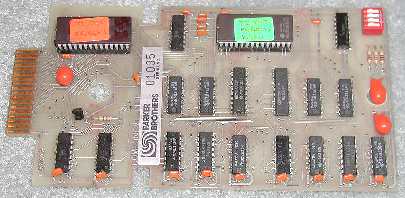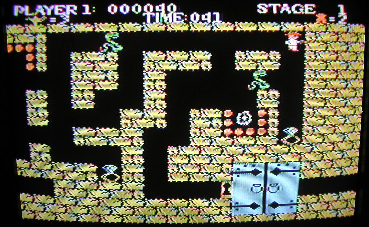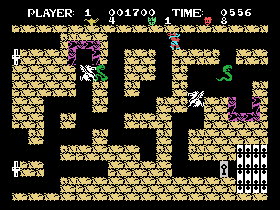

... Steve Zedeck
By Scott Stilphen

DP: What’s your educational background?
Steve Zedeck: I have a Bachelor of Science in Computer Engineering from Syracuse University, 1978. After graduation, I worked at IBM in Endicott, NY from June 1978 till May 1981. Afterwards I worked at Raytheon in Norwood, MA as a Diagnostics Software Engineer, from May 1981 till March 1983, before joining Parker Brothers.
DP: What inspired you to go into game design?
Steve Zedeck: It was a very strange and random event. I was working at Raytheon and I happened to come across an ad in the Boston Globe newspaper; Parker Brothers was seeking software engineers and programmers to write video games. I had never thought about it until then. I always played video games though. I thought it would be really cool to write video game software. It seemed much more interesting than working on commercial and military equipment for Raytheon. So, I applied for the job, hit it off very well with several of the interviewers, and the rest as they say is “history”. I joined Parker Brothers in March of 1983.
DP: Were there any programmers or games that inspired you?
Steve Zedeck: I never knew the names of any game programmers until I joined Parker Brothers. As for games, I liked Pac-Man, Tetris, and several adventure and action-type games. After joining Parker Brothers, I fell in love with the game Q*Bert. I learned the flow of the game and eventually was able to play indefinitely. I could insert a quarter into the Q*Bert arcade game and play as long as I wanted. It was so cool.
DP: What was the development process like?
Steve Zedeck: For the most part, each game was a 1 or 2-person programming/software team, though there were sound engineers and graphic artists who acted as a shared resource to all the game programmers, (as I recall, keep in mind this is 20+ years ago). Many of us used software development systems or emulators to write, debug and test the software. I used the Kontron emulator which emulated the TI 9900 processor, included the assembler, debuggers, etc. Since my game was Tutankham, an adaptation of the arcade game, I had to learn the entire game by playing the Konami arcade version. I would play for hours and hours in order to learn the flow, strategy, all the various levels, etc. The sound and graphics engineers were able to create sound files by recording the actual sound for each and every game event and digitizing it in such a way that I could feed it to the sound processor in the TI-99/4a. As for the graphics, the graphic artists created sprites (16x16 pixel cells) that I used for the game graphics and images. All the sound and graphics data was stored in a separate “grom” for the TI-99/4a. The 6K GROM was in addition to the 8K program ROM.
 DP: What was the
easiest/hardest part of designing it?
DP: What was the
easiest/hardest part of designing it?
Steve Zedeck: The easiest and probably the most fun part of writing game software is that you see the game come to life each and every day. One day I’d add more scrolling of the background, the next day I’d add more hit detection and collision, the next day I’d add more sounds or animation, etc. It’s really a lot of fun. As for the hardest, we had small code space requirements. Most games were anywhere from 4K to 16K. After completing all the game features, my code stood at about 200 bytes over 8K. I think I spent a week, doing lots of optimizing and code tricks to try to save a few bytes here and there. In the end, my game finally fit in the 8K code space with maybe 4 or 8 bytes to spare.
DP: Were there any features you would have liked to added, or any known bugs or glitches that gave you trouble (or never got resolved)?
Steve Zedeck: There is one “bug” that will remain a secret and appears randomly (if ever). It could also be thought of as a “feature”. If you ever see it, you could imagine this was added as a feature, but it wasn’t.
DP: Was there a Tutankham ”team” (as with Frogger II, where several programmers all working concurrently on versions for various platforms)?
Steve Zedeck: There wasn’t really a Tutankham team, except I did work closely with the developer of Tutankham on Colecovision, George French. The Colecovision and the TI-99/4a share the same TI graphics chip, so we were able to share lots of the sprites and images. If you look at both games, you’ll see a resemblance. Besides the graphics, there isn’t anything else we could share since both systems had different microprocessors and sound chips.


Left: TI-99/4a version Right: Colecovision version
DP: Was Tutankham the only game you worked on?
Steve Zedeck: Except for some IBM PC Jr. and Apple II games, where I worked as a project leader, Tutankham was the only game I worked on from start to finish. I was the only in-house programmer working on the TI-99/4a games. However, I worked with some of the consultants who did other TI games. The one I remember the most was the company in NJ who did TI Popeye. I gave them the code for the opening screen, so all PB/TI games looked the same when it started. They also did lots of the “reverse-engineering” and helped me a lot with understanding how to interface with the operating system and startup code in the TI-99/4a.
DP: Do you know who programmed these other TI games?
Steve Zedeck: I really don’t remember. I know there was a consulting company I visited with a few times in NJ. I know they did Popeye. They also may have been the same folks who did Q*Bert
DP: Do you recall any games or projects that you or others worked on that ultimately never got released or even finished?
Steve Zedeck: Besides Tutankham, there may have been a couple other TI projects that never got released. Some of them may not have been far enough along in development anyway. Tutankham was all complete and ready to go to production when PB decided to exit the market for TI cartridges completely. This was a great shock to me especially since it was done. When Texas Instruments decided to drop the TI-99/4a platform, PB very soon decided also to drop all marketing of TI games. I later worked on some IBM PC Jr and Apple II games as a team leader. These too were never released and I don’t recall the name of those games.
DP: Occasionally, programmers would put little “Easter eggs” in some of their games that would reveal their name, or a message. Are there Easter eggs in any of your title(s)? Do you recall any fellow co-workers that did?
Steve Zedeck: No I didn’t and I don’t recall others who did.
DP: If you had a chance to redo any of your game(s), what would you change (if anything)?
Steve Zedeck: I would not redo anything except that I wish it would have been marketed.
DP: It’s a shame PB decided not to release Tutankham, especially since it was so close to being released. It really doesn’t make sense for PB to immediately drop TI support, since the installed user base was still very much active, and they had already paid for Tutankham’s development. What was their reasoning (if any)?
Steve Zedeck: It was totally a marketing decision at that point. The game wasn’t “close” to being released. From a development perspective, it was released. It was done except for the small expense to convert the development board to an actual cartridge. I do recall there was a point during my development where the marketing folks had a target price in mind for TI Tutankham. After a while, due to market conditions and TI-99/4a sales relative to other platforms, the target price for my game dropped. I think when TI actually decided to drop the platform that probably dropped my target price even further; to the point that Marketing may have though it wasn’t worth it to go to full production and enter the sales channel.
DP: When and/or why did you leave PB?
Steve Zedeck:
In May 1984, PB laid off ALL of the game engineering team
from the VP on down to the secretaries (about 85 people). As I recall, there was
at least 2 rounds of layoffs in February and March 1984. I was affected in the
last round. My life as a game developer was over.
However, I was able to leverage my new background in graphics with my previous
background in Diagnostics software to land a position at Apollo Computer as a
Graphics Diagnostics Software Engineer. I spent the next 11 years there. Over
the years I’ve worked for some of the major computer and telecommunications
companies in the world, as a software engineer and as a manager and director.
I’ve worked for Apollo Computer, Hewlett Packard, Cascade Communications, Lucent
Technologies, Sonus Networks, and Mercury Computer Systems.
DP: What were some of your experiences working for PB?
Steve Zedeck: It was probably the most fun job I’ve ever had. It’s also the only job where I can tell people what I do and they can understand and appreciate it. It was a great team of people. We had lots of fun. Our lab was basically a full-blown arcade with every game you can imagine. To be able to hear the sounds of various games all day, was awesome. These are some very creative people.
DP: Any stories or anecdotes from those days that you recall?
Steve Zedeck: My wife and I were married in August 1983, while I was working at Parker Brothers, and heavy into my obsession with Q*Bert - a game that I could play infinitely with only one quarter. We were going on our honeymoon to Hawaii. Our flight took off from Boston, had a 2 hour layover in San Francisco and then onto Hawaii. During our layover in San Francisco airport I found an arcade, of course with a Q*Bert machine. So I started to play, and I played, and I played, and I played. My score was probably in the hundreds of thousands with over a dozen “extra” Q*Berts, when they started to announce the boarding for our flight. I kept playing. As you can imagine, my wife (of one day at that point) was upset to say the least! So when they announced the last call for our flight, I had to stop playing. There was a young kid there watching me play in total awe as I kept scoring and going to higher and higher levels. I told the kid that I had to leave and that he can take over the controls from me. At that point, at the highest of levels, it was too fast for him. As I walked, actually ran, away to catch the flight, all I could hear was the sounds of “dying” Q*Berts. Needless to say, my wife and I had a long discussion on the plane about my passion for video games. I am proud to say that we are still married and have just celebrated our 23rd anniversary.
DP: Which of your titles are your favorite, and what types of games in general?
Steve Zedeck: From a developer standpoint, I really like Tutankham. I like adventure games where you look for things and explore areas.
DP: Have you stayed in touch with any of your former co-programmers?
Steve Zedeck: I wish I would have but I haven’t. Since Parker Brothers, I have become very involved in embedded firmware and Diagnostics software and continue to stay in contact with many former co-workers in these areas.
DP: What are your thoughts on how the industry has evolved
Steve Zedeck: It’s nothing like it used to be. Games today are more like motion pictures/movies with huge development budgets and engineering teams. Back then, a game was a 1 or 2-person project (maybe 3 or 4 if you include the graphics and sound engineers). Now it’s in the hundreds and there is virtually no limit on storage space with DVD-based games.
| GAMEOLOGY |
| GAME | SYSTEM | COMPANY | STATUS |
| Tutankham | TI-99/4a | Parker Brothers | unreleased |